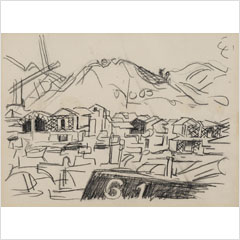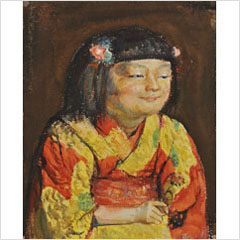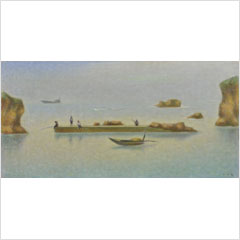
須田国太郎
下田
1956(昭和31)年頃 コンテ・紙 27.0×36.5cm
Kunitaro Suda
Shimoda
c. 1956 (Showa 31) Conte on paper 27.0 × 36.5 cm
1954(昭和29)年6月、伊豆風景を描くために招かれた須田国太郎は、一週間の写生旅行をしました。韮山、古奈、下田、石廊崎、松崎、三島などに立ち寄り、各所でスケッチをしながら伊豆を廻ったようです。日記には、「バスで下田へ向かう 割合平凡 天城山横断は流石によし 市中あるく なまこ壁眼につく ここでかくつもりにする」と記されています。
また、数年後には下田港から武山(寝姿山)を望むスケッチ《下田》を描いています。前景に堤防が見え、なまこ壁が並ぶ街の手前には多くの船がひしめいており、当時造船業で栄えた下田の賑わいが垣間見えます。ここでは手前にみえる船よりも、遠景にある2階建てのなまこ壁の倉庫をつぶさに描いており、旅行中須田がよく眼についたというなまこ壁への関心があらわれています。
In June 1954, Kunitaro Suda was invited to paint the landscapes of Izu and embarked on a week-long sketching trip. He visited places such as Nirayama, Kona, Shimoda, Irozaki, Matsuzaki, and Mishima, sketching at various locations as he traveled around Izu. His diary notes, "Heading to Shimoda by bus. Relatively ordinary. The crossing of Mount Amagi is indeed good. Walking around the town, the namako walls catch my eye. I plan to paint here."
A few years later, he created a sketch titled "Shimoda," depicting the view of Mount Nesugata from Shimoda Port. In the foreground, a breakwater is visible, and many boats crowd the area in front of the town lined with namako walls, reflecting the bustling shipbuilding industry of Shimoda at the time. Here, Suda meticulously depicted the two-story namako-walled warehouses in the background, showing his keen interest in the namako walls that frequently caught his eye during his travels.







